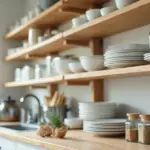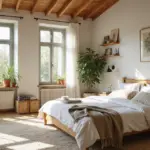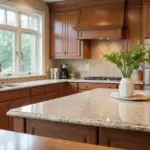I’ve always been fascinated by how farmhouse kitchens blend rustic charm with practical functionality. Despite my expertise in modern zen design, there’s something deeply calming about the unpretentious elegance of a well-designed farmhouse space. It’s not just about aesthetics—it’s about creating a kitchen that feels like a warm embrace when you walk in.
Ready to transform your kitchen into something special? Let’s explore 20 farmhouse kitchen ideas that balance rustic elements with thoughtful design principles. The result? A space that’s both beautiful and purposeful—a true haven in your home.
1. Embrace the Timeless Charm of Shiplap Walls
Shiplap isn’t just trendy—it’s transformative. These wooden boards with their distinctive rabbet joints were originally used as exterior siding, but they’ve found new life indoors. The horizontal lines create visual flow while adding texture that flat walls simply can’t match. What I love most is how shiplap whispers stories of craftsmanship and history, bringing authentic character to modern spaces.

You can use shiplap in various ways—covering entire walls for dramatic impact, as a durable backsplash alternative, or to add texture to kitchen islands. The beauty of shiplap in farmhouse kitchens is its versatility—paint it creamy white for classic appeal or try moody navy for contemporary contrast. Either way, it anchors your design with timeless charm.
Here’s the catch—installing shiplap requires precision. Make sure your walls are level before beginning, and consider how the lines will interact with other elements in your kitchen. The effort is worthwhile, though, as few features capture farmhouse essence so completely.
2. Center Your Kitchen Around a Classic Farmhouse Sink
The farmhouse sink is where function meets beauty in the most perfect way. That distinctive apron front extending beyond the countertop creates an immediate focal point that draws the eye. These deep, spacious basins weren’t designed for looks—they evolved from the practical needs of farm life, where washing large pots and garden harvests required serious space.

Choosing the right material matters tremendously. While fireclay offers traditional appeal and impressive durability, stainless steel brings a contemporary edge that works beautifully in modern farmhouse kitchens. Cast iron with enamel coating delivers dramatic visual impact, and composite granite provides stain resistance in various colors. Your choice should reflect both your aesthetic vision and how you’ll use the kitchen daily.
Picture it this way—a white fireclay sink paired with a rich butcher block countertop creates a contrast that’s both striking and inviting. This combination becomes the heart around which your entire kitchen design can flow.
3. Showcase Your Style with Open Shelving for Dishes and Decor
Open shelving does something magical in farmhouse kitchens—it transforms storage into storytelling. Beyond mere practicality, these exposed shelves create a stage for displaying your personality through carefully curated collections. The absence of cabinet doors opens up the space visually while encouraging a mindful approach to what you keep and display.

The key to successful open shelving lies in thoughtful curation. Display matching dishware sets, clear glass jars filled with pantry staples, vintage pitchers, wooden cutting boards, and perhaps a few small potted herbs. The art is in creating balanced arrangements that feel intentional rather than cluttered. Remember, what you choose not to display is as important as what you do.
- Use reclaimed wood shelves to enhance rustic appeal
- Install at varying heights to accommodate different items
- Group similar items together for visual cohesion
- Include a mix of practical and decorative elements
- Rotate seasonal items to keep the look fresh
What really matters here is creating a display that feels authentic to you. The best farmhouse kitchens ideas reflect the personalities of those who cook and gather there.
4. Warm Up Your Space with Butcher Block Countertops
Butcher block countertops bring something to a kitchen that few other materials can—genuine warmth. The natural wood grain creates an inviting atmosphere that immediately makes the space feel more homely. Unlike the cool precision of stone or the manufactured uniformity of laminate, wood carries subtle variations that give your kitchen soul.

The wood you select dramatically impacts both aesthetics and performance. Maple stands out for its hardness and versatility, while walnut offers luxurious dark tones. Cherry brings a warm reddish hue that deepens beautifully with age, and oak delivers distinctive grain patterns with impressive durability. For a budget-friendly option that doesn’t sacrifice style, consider birch with its light, clean appearance.
My breakthrough came when I realized butcher block isn’t just a countertop material—it’s a design philosophy. It represents choosing natural elements that age gracefully and develop character through use, perfectly aligning with farmhouse kitchens’ emphasis on authentic materials and lived-in beauty.
5. Add Architectural Interest with Exposed Wooden Beams
Exposed wooden beams transform ordinary ceilings into architectural statements. These elements draw the eye upward, creating a sense of height while adding undeniable character. Whether structural or decorative, beams evoke rustic charm and historical significance that resonates deeply with farmhouse aesthetics.

Selecting the right wood makes all the difference. Reclaimed timbers from old barns or factories bring authentic weathering and patina that new materials simply can’t replicate. However, new wood can be effectively distressed or stained to achieve a similar character. The color should harmonize with your overall palette—darker woods create drama and coziness, while lighter tones enhance brightness and airiness.
Let me paint you a picture: imagine walking into a kitchen where rough-hewn beams cross a white ceiling, creating striking contrast and visual rhythm. This single element can anchor your entire design, providing the perfect framework for all your other farmhouse kitchen ideas to shine.
6. Illuminate with Rustic Pendant Lighting Over the Island
Pendant lighting above a kitchen island serves dual purposes that are equally important. Functionally, it provides targeted illumination for food prep and dining. Aesthetically, these hanging fixtures create a visual centerpiece that defines the space and adds vertical interest. The right pendants can transform your island from merely functional to genuinely spectacular.

The materials you choose for pendants speak volumes about your farmhouse style. Metal finishes like aged bronze or galvanized steel introduce industrial elements that complement rustic wood. Glass shades—whether clear, seeded, or frosted—beautifully diffuse light while showcasing vintage-inspired bulbs. For truly unique options, consider repurposed mason jars or fixtures incorporating natural rope details.
“Lighting is the jewelry of the home. Choose pendants that make your heart sing every time you walk into your kitchen.”
The tricky part is getting the scale right. Pendants that are too small disappear visually, while oversized fixtures can overwhelm the space. Consider both the island dimensions and ceiling height when selecting size and hanging height.
7. Infuse Personality with Vintage Finds and Antique Accents
Vintage and antique pieces are the storytellers in farmhouse kitchens. Unlike mass-produced items, these treasures carry history in their patina and imperfections. They inject authentic character that elevates your kitchen beyond mere trend-following, creating a space that feels collected over time rather than purchased in a single shopping trip.

Hunt for pieces with both visual appeal and practical purpose. Vintage scales make charming countertop displays while antique breadboxes offer stylish storage. Enamelware pieces introduce delightful color pops, and old cutting boards bring organic texture to walls. Even something as simple as displaying vintage utensils in a crock adds significant character with minimal investment.
Do you see how huge that is? These personal touches transform a kitchen from a showroom display to a living space that tells your unique story. The best farmhouse kitchens ideas incorporate elements that spark conversation and connection—exactly what these vintage finds accomplish.
8. Create a Serene Backdrop with a Neutral Color Palette
A neutral color palette provides the perfect canvas for farmhouse kitchens. These understated hues allow textural elements like wood, stone, and textiles to take center stage without competition. Think of neutrals as the supporting actors that make the stars shine brighter—they’re essential but don’t demand attention themselves.

When crafting your neutral palette, explore the remarkable depth within seemingly simple colors. Whites range from warm creamy tones to cooler shades with subtle blue undertones. Beiges and greiges (gray-beige blends) offer sophisticated warmth, while soft grays add modern refinement. Even muted sages and dusty blues can function as neutrals when used with restraint, adding subtle color without overwhelming the space.
The game-changer happened as I realized that neutrals aren’t boring—they’re intentional. They create visual calm that allows for seasonal changes through accessories and décor. This flexibility is particularly valuable in farmhouse kitchens where natural elements and vintage finds need room to shine.
9. Connect with Nature Using Natural Wood Cabinetry
Natural wood cabinetry creates an immediate connection to the outdoors, bringing organic warmth into your kitchen. Unlike painted cabinets that conceal the material beneath, wood cabinetry celebrates its natural beauty—grain patterns, knots, and color variations become design features rather than flaws to hide.

Different wood species create distinctly different moods. Oak, with its prominent grain, brings traditional farmhouse character. Maple offers a smoother, more refined look while still feeling authentic. Pine, with its knots and imperfections, delivers undeniable rustic charm. For the ultimate in character and sustainability, consider reclaimed wood that carries visible history in every scratch and mark.
Here’s where it gets interesting—natural wood doesn’t have to mean dark and heavy. Modern farmhouse kitchens often feature lighter wood tones that brighten the space while maintaining that essential connection to nature. This balance of light and warmth creates kitchens that feel both fresh and timeless.
10. Add Cozy Texture with Woven Rugs and Textiles
Textiles transform a kitchen from purely functional to genuinely comfortable. In spaces dominated by hard surfaces—tile floors, stone countertops, wood cabinetry—soft textiles provide necessary contrast and comfort underfoot. They’re the elements that make a farmhouse kitchen feel lived-in rather than just looked-at.

Natural fiber rugs like jute or sisal bring organic texture and impressive durability, making them perfect for high-traffic kitchen areas. For pattern and color, consider vintage-inspired kilim rugs or washable cotton options with classic stripes or checks. Beyond rugs, incorporate textiles through linen dish towels, cotton curtains, or chair cushions in farmhouse-friendly fabrics like ticking stripe or grain sack.
It’s similar to how a cozy sweater transforms how you feel on a chilly day—textiles bring that same sense of comfort to your kitchen. They soften both the visual and acoustic environment, making the space more inviting for lingering conversations and shared meals.
11. Bring the Outdoors In with Fresh Herbs and Greenery
Plants breathe life into farmhouse kitchens—literally and figuratively. Fresh herbs and greenery add vibrant color, pleasant fragrance, and a sense of vitality that no other decorative element can match. They soften hard edges and create a direct connection to the agricultural roots that inspire farmhouse style.

Focus on varieties that thrive indoors with minimal fuss. Herbs like basil, mint, rosemary, thyme, and chives offer both beauty and culinary benefits. For decorative plants, consider resilient options like snake plants, pothos, spider plants, or succulents that forgive occasional neglect. Display them in terracotta pots, vintage crocks, or repurposed containers that enhance your farmhouse aesthetic.
The heart of the matter is that plants make a kitchen feel alive and nurturing—exactly the feeling that the best farmhouse kitchens strive to create. They remind us that kitchens are spaces of growth, nourishment, and care.
12. Design a Gathering Hub with a Spacious Kitchen Island
A generous kitchen island transforms how people interact in the space. It’s not just additional counter space—it’s a social hub that invites gathering, conversation, and collaboration. In the spirit of traditional farmhouses where kitchens were centers of family life, a well-designed island creates opportunities for connection during everyday moments.

Several elements give an island that quintessential farmhouse feel. Natural materials like butcher block or reclaimed wood bring immediate warmth and character. Architectural details such as turned legs or corbels add visual interest and historical reference. Incorporating a farmhouse sink or open shelving enhances both functionality and style. The key is creating an island that serves as both a practical workspace and an inviting gathering spot.
What unfolded next was fascinating—I discovered that the most successful islands balance form and function in equal measure. They provide ample workspace while also accommodating casual dining, homework sessions, or friendly conversations over wine. This versatility is what makes an island the true heart of modern farmhouse kitchens.
13. Opt for a Durable and Stylish Stone or Tile Backsplash
Backsplashes in farmhouse kitchens need to work hard while looking beautiful. The ideal backsplash material resists moisture, heat, and stains while contributing to the overall aesthetic. The vertical surface between countertops and cabinets offers a perfect opportunity to introduce texture, pattern, or color that enhances your design vision.

Classic subway tile remains enduringly popular for good reason—its simple form adapts to various arrangements from traditional horizontal stacking to more dynamic herringbone patterns. Natural stone options like stacked stone or slate bring organic texture and subtle color variation. Brick, whether authentic or veneer, adds rustic character that pairs beautifully with other farmhouse elements. For pattern lovers, consider handmade tiles with subtle imperfections or patterned tiles in muted, farmhouse-friendly colors.
The missing piece is often how these materials interact with lighting. Notice how different backsplash materials reflect light differently throughout the day, creating subtle mood changes from morning to evening. This dynamic quality adds depth to farmhouse kitchens that static elements can’t provide.
14. Introduce Rustic Elegance with Reclaimed Wood Elements
Reclaimed wood brings something invaluable to farmhouse kitchens—authentic history. Each board carries visible evidence of its previous life—saw marks, nail holes, weathering, and patina that new materials simply cannot replicate. These imperfections aren’t flaws; they’re character that tells a story and adds soul to your space.

Look for opportunities to incorporate reclaimed wood throughout your kitchen. A stunning island base instantly becomes a conversation piece. Open shelving showcases both the wood’s beauty and your displayed items. An accent wall creates dramatic impact, while cabinet doors or panels add subtle texture. Even smaller touches like a reclaimed wood backsplash or countertop bring significant character to the overall design.
The surprising part is how reclaimed wood bridges different farmhouse styles. Whether your vision leans traditional, modern, industrial, or eclectic, reclaimed wood elements add authenticity that grounds the design. They’re the common thread that makes diverse farmhouse kitchens ideas feel connected to shared historical roots.
15. Maximize Space with Smart and Stylish Storage Solutions
Thoughtful storage solutions maintain the balance between functionality and aesthetics in farmhouse kitchens. The goal isn’t just organization—it’s creating systems that support daily life while preserving the warm, collected feel that makes farmhouse style so appealing.

Begin by assessing how you actually use your kitchen, not how magazine spreads suggest you should. Place frequently used items within easy reach. Consider vertical storage opportunities like wall-mounted racks for pots or utensils. Look for furniture-style pieces that add character while providing storage—a vintage hutch, a freestanding island, or a repurposed cabinet. Choose materials that enhance your farmhouse aesthetic, like wire baskets, wooden crates, or glass jars.
- Install a ceiling-mounted pot rack to free up cabinet space
- Use pegboard for flexible, visible storage of cooking tools
- Incorporate a plate rack for displaying everyday dishes
- Add hooks under shelves for hanging mugs or measuring cups
- Repurpose vintage containers for utensil storage
Let me show you another perspective—the most successful farmhouse kitchens balance visibility and concealment. Some items deserve to be displayed, while others function better behind closed doors. Finding this balance creates spaces that feel both organized and organically evolved.
16. Ground Your Design with Classic Checkered or Brick Flooring
Flooring anchors your entire kitchen design, and traditional patterns like checkered tile or brick create an immediate sense of history and authenticity. These classic options have adorned farmhouse kitchens for generations, providing durability and timeless style that contemporary alternatives often lack.

Checkered floors, particularly in black and white, create visual energy and pair beautifully with various color schemes. They reference historical patterns while feeling surprisingly current. Brick flooring brings warmth through its natural terracotta tones and irregular texture. Both options hide dirt well—a practical consideration in busy kitchens—and develop character over time rather than simply wearing out.
The breakthrough came when I realized flooring isn’t just about what’s underfoot—it establishes the foundation for everything above. The pattern and scale of your flooring influence how other elements are perceived. A bold floor pattern might suggest simpler cabinetry, while a more subtle floor allows for more decorative elements elsewhere.
17. Warm Up Metallic Accents with Copper Pots and Pans
Copper cookware brings unmatched warmth to farmhouse kitchens. The rich, reddish-brown hue creates beautiful contrast against white cabinetry or cooler metals like stainless steel. As copper naturally patinas over time, it develops a lived-in character that perfectly complements the farmhouse aesthetic’s appreciation for materials that age gracefully.

Display your copper pieces strategically for maximum impact. A pot rack above an island creates a stunning focal point while keeping cookware accessible. Open shelving offers another showcase opportunity, allowing copper’s warmth to shine alongside other decorative elements. Even a few carefully placed pieces on a countertop can add significant visual warmth to the space.
What complicates this is finding the right balance—too much copper can overwhelm, while too little might get lost. The goal is creating purposeful moments of warmth that enhance the overall design without dominating it. When done right, copper elements become the jewelry of your farmhouse kitchen, adding that perfect finishing touch.
18. Organize and Display with Charming Mason Jars
Mason jars embody the farmhouse spirit of practicality meeting beauty. These humble glass containers were created for food preservation, but their simple, functional design has made them enduringly appealing for various uses. Their transparency allows contents to become part of your kitchen’s visual story, while their history connects to traditional homemaking practices.

Beyond storing dry goods, mason jars offer countless creative possibilities. Transform them into drinking glasses, soap dispensers, or utensil holders. Mount them horizontally for unique spice storage. Use them as vases for fresh flowers or containers for small herb plants. With pendant light kits, they become distinctive lighting fixtures that enhance your farmhouse aesthetic.
The stumbling block is avoiding the “too much of a good thing” trap. Mason jars work best when their use feels intentional rather than overwhelming. Select a few meaningful applications rather than incorporating them everywhere. This restraint ensures they enhance your farmhouse kitchen rather than turning it into a mason jar showcase.
19. Enhance Authenticity with Rustic Cabinet Hardware
Cabinet hardware might seem like a small detail, but it significantly impacts how your kitchen feels and functions. These touchpoints—the knobs and pulls you interact with daily—can either enhance or undermine your farmhouse aesthetic. The right hardware adds authenticity and character while improving the tactile experience of using your kitchen.

For genuine farmhouse appeal, look to materials with history and patina. Wrought iron brings a hand-forged quality that feels authentically rustic. Antique brass or oil-rubbed bronze adds warmth and aged character. Pewter offers subtle sophistication with a slightly softer appearance. Even simple wooden knobs can bring charming handcrafted appeal to painted cabinetry.
The crucial element is consistency in quality rather than strict matching. Farmhouse kitchens often feature hardware that appears collected over time rather than purchased as a matched set. This approach creates more authentic character while still maintaining a cohesive look through similar finishes or complementary styles.
20. Create a Cozy Breakfast Nook for Casual Dining
A breakfast nook transforms a corner of your kitchen into a dedicated space for connection. Unlike formal dining rooms, these intimate areas encourage lingering over morning coffee, casual family meals, or quiet moments with a book. They embody the farmhouse principle that kitchens should nurture both body and relationships.

The most inviting breakfast nooks combine several key elements. Comfortable seating is essential—whether a built-in banquette, a window seat, or cushioned chairs that encourage relaxation. A right-sized table creates a gathering point without overwhelming the space. Natural light enhances the appeal, supplemented by warm pendant lighting for evening use. Textural elements like cushions, throws, or shiplap walls add coziness and define the area as distinct from the working kitchen.
Things took an interesting turn when I began seeing breakfast nooks as microcosms of the entire farmhouse aesthetic—they combine practicality, comfort, and charm in a small, focused area. When thoughtfully designed, these nooks become favorite spots that family and guests naturally gravitate toward, fulfilling the ultimate goal of farmhouse kitchens: creating spaces where people want to gather.
Bringing Your Farmhouse Kitchen to Life
Creating your dream farmhouse kitchen isn’t about following trends or checking boxes—it’s about crafting a space that feels authentically yours. The most successful farmhouse kitchens blend practical functionality with personal touches that tell your unique story. They honor traditional elements while adapting to modern life.
As you implement these farmhouse kitchen ideas, let your decisions be guided by how you actually live and what truly matters to you. Choose materials that will age beautifully with use. Incorporate elements that spark joy when you see them. Design for the real moments of your life—from hurried breakfast preparations to leisurely Sunday baking sessions.
The beauty of farmhouse style lies in its forgiving nature. Imperfections aren’t flaws—they’re character. Mismatched elements aren’t mistakes—they’re evidence of a space that’s evolved over time. Your farmhouse kitchen should feel like a warm hug every time you enter it, welcoming you home with open arms and inviting you to create, gather, and simply be.






